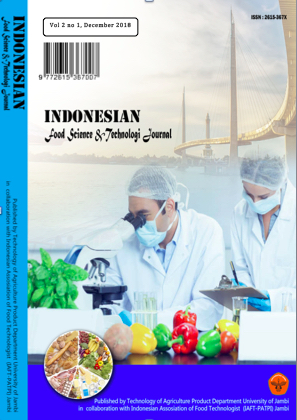The Environmental effects on fortified palm olein in the Anthropocene
DOI:
https://doi.org/10.22437/ifstj.v2i1.6421Keywords:
Vitamin A, Shelf-life, Illuminance, Stability, Fortified palm, packagingAbstract
Until now, no literature exists to explain about the impact of time, and environmental parameters, when using typical commercial grade transparent linear low density polyethylene (LLDPE) packaging for protecting vegetable cooking oil during typical shelf-life conditions. We tested long-term impact of temperature and illuminance (light: 100 to 150 lux and darkness <1 lux) on refined bleached deodorized palm olein (RBDPOL), fortified with vitamin A. Results showed degradation of fortified RBDPOL with 70 ppm vitamin A was approximately 15% at 18-22oC in Light, 10% at 18-22oC in Darkness, 19% at 32-33oC in light and 17% 32-33oC in darkness. Similar trend was observed at 45 ppm vitamin A.
Exposure to heat and light impacted vitamin A degradation, but is primarily attributed to temperature, irrespective of packaging. This investigation builds on our previous work (Silalahi et al., 2017), and confirms the impact of challenging environmental conditions on vegetable cooking oil shelf-life over long time periods.
Downloads
References
[2]. Global Alliance for Improved Nutrition (GAIN) (2010). Fortification of vegetable oil in Indonesia. www.gainhealth.org/knowledgecentre/project/fortification-vegetable-oil-indonesia.
[3]. Riskesdas (Riset kesehatan dasar) (2010). National report on basic health research by national institute of health research and development. Indonesia: Ministry of Health.
[4]. Soekirman, Soekarjo, D., Martianto, D., Laillou, A. & Moenchpfanner, R. (2012). Fortification of Indonesian unbranded vegetable oil: public – private initiative, from pilot to large scale. Food and Nutrition Bulletin, 33, S301–S302.
[5]. Silalahi, D. K., Yuliyanti, D. , da Silva, M. , Christianti, I. , Mulyono, K. and Wassell, P. (2017), The stability of vitamin A in fortified palm olein during extended storage and thermal treatment. Int J Food Sci Technol, 52: 1869-1877. doi:10.1111/ijfs.13462.
[6]. FAO/WHO (2004). Vitamin and mineral requirements in human nutrition, 2nd ed. Report of a joint FAO/WHO expert consultation, Bangkok. Gwanfogbe, P.N., Chambers, E.I., Martin, G., Fotso, M., & Smith.
[7]. FAO/WHO (2006). Guidelines on food fortification with micronutrients. Allen, L, Benoist, Bruno de, Dary, O., et al.
[8]. Atwood, S.G., Sanghvi, T.G., Sharma, V. & Carolan, N. (1995). Stability of vitamin A in fortified vegetable oil and corn soy blend used in child feeding programs in India. Journal of Food Composition and Analysis, 8, 32–44.
[9]. Farhang, B and Nikoopur, H. (2004) the effect of light and temperature on stability of vitamin A in the fortified vegetable oils (hydrogenated and nonhydrogenated). Asia pacific journal of clinical nutrition 2004.
[10]. Combs Jr, G.F. (2008). The Vitamins: Fundamental aspect in nutrition and health. Elsevier.inc. 3rd ed.
[11]. Hariyadi, P. (2009). Technical aspects of oil fortification with vitamin A. Industrial Role of Cooking Oil Fortification with Vitamin A in Indonesia. Southeast Asian Food & Agricultural Science & Technology (SEAFAST) Center, Bogor Agricultural University, BOGOR, Indonesia. April 21, 2009.
[12]. Andarwulan, N., Gitapratiwi, D., Laillou, A. et al. (2014). Quality of vegetable oil prior to fortification is an important criteria to achieve a health impact. Nutrients, 6, 5051–5060.
[13]. Siracusa, V. (2012). Food packaging permeability behaviour: a report. International Journal of Polymer Science, 1–11.
[14]. Dwyer, J.T., Wiemer, K.L., Dary, O. et al. (2015). Fortification and health: challenges and opportunities. Advances in Nutrition, 6, 124–131. https://doi.org/10.3945/an.114.007443
[15]. Barrett, A. H., Richardson, M. J., Froio, D. F., O’Connor, L. F., Anderson, D. J. and Ndou, T. V. (2018). Longâ€Term Vitamin Stabilization in Low Moisture Products for NASA: Techniques and Threeâ€Year Vitamin Retention, Sensory, and Texture Results. Journal of Food Science, 83: 2183-2190. doi:10.1111/1750-3841.14218
[16]. Carlotti, M.E., Rossatto, V., Gallarate, M., et al. (2004). Vitamin A palmitate photostability and stability overtime. J. Cosmet. Sci., 55, 233-252.
[17]. Andarwulan, N., Muhammad, G.N., Agista, A.Z. et al. (2016). Photo oxidation stability of palm oil fortified by red palm oil. Journal Teknol. and Food Industry, 27, 31–39. ISSN: 1979-7788.
[18]. Hemery, Y.M., Fontan, L., Moench-Pfanner, R. et al. (2015). Influence of light exposure and oxidative status on the stability of vitamins A and D3 during the storage of fortified soybean oil. Food Chemistry, 184, 90–98.
[19]. Pignitter, M., Hernler, N., Zaunschirm, M. et al. (2016). Evaluation of palm oil as a suitable vegetable oil for vitamin a fortification programs. Nutrients, 8, 378. doi:10.3390/nu8060378.
[20]. Howell, R., Rosario, L., Bula, A. (1997) Effects of indoor relative humidity on refrigerated display case performance. In: Proceedings of CLIMA 2000, Brussels, Belgium.
[21]. BMKG (Badan Meteorolgi, Klimatologi, dan Geofisika) (2017). Minimum and Maximum temperature Tanjung Priok Jakarta at 1981-2010. http://web.meteo.bmkg.go.id/id/iklim (5 January 2018)
[22]. Japanese Industrial Standard (2006) JIS C 1609-1 Illuminance meters Part 1: General measuring instruments. ICS Code (Optical measuring instruments): 17.180.30. Pub: Japanese Standards Association.
[23]. CIBSE (2012). Lighting Guide 01: The Industrial Environment LG01. Chartered Institute of Building Service Engineers.
[24]. Bagriansky, J. & Ranum, P. (1998). Vitamin A fortification of PL 480 vegetable oil. US Agency for International Development,1–29.
[25]. Association of Analytical Chemists (2011). AOAC official method 2001.13. Vitamin A (retinol) in foods, liquid chromatography, 19th ed., Chapter 45.1.
[26]. Birch, K. (2003). Estimating uncertainties in testing, measurement good practice guide No. 36. British Measurement and Testing Association. ISSN 1368-6550.
[27]. Pignitter, M., Dumhart, B., Gartner, S. et al. (2014a). Vitamin A is rapidly degraded in retinyl palmitate-fortified soybean oil stored under household conditions. Journal of Agricultural and Food Chemistry, 62, 7559–7566.
[28]. Pignitter, M., Stolze, K., Gartner, S. et al. (2014b). Cold fluorescent light as major inducer of lipid oxidation in soybean oil stored at household conditions for eight weeks. Journal of Agricultural and Food Chemistry, 62, 2297–2305.
[29]. Osendarp, S.J.M., Martinez, H., Garrett, G.S. et al. (2018). Large-Scale Food Fortification and Biofortification in Low- and Middle-Income Countries: A Review of Programs, Trends, Challenges, and Evidence Gaps. Food and Nutrition Bulletin. 39 (2) pp. 315-331 https://doi.org/10.1177/0379572118774229
Downloads
Published
Versions
- 2018-12-20 (1)
- 2018-12-20 (1)









